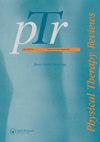Virtual reality in physical rehabilitation: a narrative review and critical reflection
IF 0.8
Q4 REHABILITATION
引用次数: 0
Abstract
Abstract Background Digital technologies are increasingly more ubiquitous with every passing year and have the potential to revolutionize how humans interact. In the realm of physical rehabilitation, the use of virtual reality (VR) is an area that has continued to see growth as a technology that could allow for new avenues of physical therapy practice. Objectives This manuscript starts with a narrative review of the emergence of virtual reality technology for use in rehabilitation and the original vision of this relationship as a means to understand its trajectory for the future. We then consider the current benefits and harms of using virtual reality technologies in the physical rehabilitation space. Major Findings VR technologies are becoming smaller and cheaper with every given year, with many new applications in physical rehabilitation (e.g. restoration of range of motion or pain control). We appear to be at a point in history where VR may be able to be successfully used on a wider scale in physical rehabilitation. The use of VR in physical rehabilitation has potential, but greater effort is required to elucidate its standardized operating procedures as well to guide the ethics in its use. Clinicians may also need to learn new competencies to implement VR effectively. Conclusions Collaboration is required between patients, clinicians, and scientists to help guide the use of VR within physical rehabilitation. This work is intended to act as a resource to clinicians and scientists in the field looking to develop a greater understanding of VR within physical rehabilitation.物理康复中的虚拟现实:叙事回顾与批判性反思
摘要背景数字技术日益普及,有可能彻底改变人类的互动方式。在物理康复领域,虚拟现实(VR)的使用是一个持续增长的领域,它是一种可以为物理治疗实践开辟新途径的技术。目的本文首先对用于康复的虚拟现实技术的出现进行叙述性回顾,并将这种关系作为理解其未来轨迹的一种手段。然后,我们考虑了在物理康复空间中使用虚拟现实技术的当前益处和危害。主要发现VR技术每年都在变得更小、更便宜,在身体康复方面有许多新的应用(例如恢复运动范围或疼痛控制)。我们似乎正处于一个历史时刻,虚拟现实可能能够在更大范围内成功用于身体康复。虚拟现实在身体康复中的使用是有潜力的,但需要更大的努力来阐明其标准化操作程序,并指导其使用的道德规范。临床医生可能还需要学习新的能力来有效地实施虚拟现实。结论需要患者、临床医生和科学家之间的合作,以帮助指导VR在物理康复中的使用。这项工作旨在为该领域的临床医生和科学家提供资源,他们希望在身体康复中更好地理解虚拟现实。
本文章由计算机程序翻译,如有差异,请以英文原文为准。
求助全文
约1分钟内获得全文
求助全文
来源期刊

Physical Therapy Reviews
REHABILITATION-
CiteScore
1.30
自引率
0.00%
发文量
26
期刊介绍:
Physical Therapy Reviews is an international journal which aims to publish contemporary reviews, discussion papers and editorials within physical therapy, and in those basic and clinical sciences which are the basis of physical therapy. The journal is aimed at all those involved in research, teaching and practice within the area of physical therapy. Reviews (both descriptive and systematic) are invited in the following areas, which reflect the breadth and diversity of practice within physical therapy: •neurological rehabilitation •movement and exercise •orthopaedics and rheumatology •manual therapy and massage •sports medicine •measurement •chest physiotherapy •electrotherapeutics •obstetrics and gynaecology •complementary therapies •professional issues •musculoskeletal rehabilitation
 求助内容:
求助内容: 应助结果提醒方式:
应助结果提醒方式:


